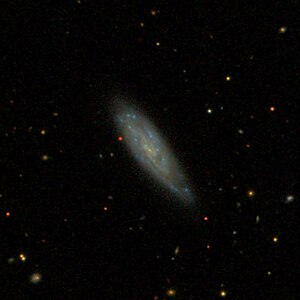NGC 4238
aus Wikipedia, der freien Enzyklopädie
| Galaxie NGC 4238 | |
|---|---|

| |
| SDSS-Aufnahme | |
| AladinLite | |
| Sternbild | Drache |
| Position Äquinoktium: J2000.0, Epoche: J2000.0 | |
| Rektaszension | 12h 16m 55,803s[1] |
| Deklination | +63° 24′ 35,7″[1] |
| Erscheinungsbild | |
| Morphologischer Typ | Sd / BrClG / HII[1] |
| Helligkeit (visuell) | 13,5 mag[2] |
| Helligkeit (B-Band) | 14,2 mag[2] |
| Winkelausdehnung | 1,80' × 0,5'[2] |
| Positionswinkel | 36°[2] |
| Flächenhelligkeit | 13,2 mag/arcmin²[2] |
| Physikalische Daten | |
| Rotverschiebung | 0.009230 ± 0.000007[1] |
| Radialgeschwindigkeit | (2767 ± 2) km/s[1] |
| Hubbledistanz H0 = 73 km/(s • Mpc) |
(129 ± 9) · 106 Lj (39,4 ± 2,8) Mpc [1] |
| Durchmesser | 70.000 Lj[3] |
| Geschichte | |
| Entdeckung | William Herschel |
| Entdeckungsdatum | 20. März 1790 |
| Katalogbezeichnungen | |
| NGC 4238 • UGC 7308 • PGC 39366 • CGCG 315-031 • MCG +11-15-041 • IRAS 12145+6341 • 2MASX J12165577+6324358 • GC 2826 • H III 851 • h 1164 • 2MASS J12165586+6324355 • NSA 161379 • NVSS J121655+632440 • WISEA J121655.88+632436.2 | |
NGC 4238 ist eine spiralförmige Radiogalaxie mit ausgedehnten Sternentstehungsgebieten vom Hubble-Typ Scd im Sternbild Drache am Nordsternhimmel. Sie ist schätzungsweise 129 Millionen Lichtjahre von der Milchstraße entfernt und hat einen Durchmesser von etwa 70.000 Lichtjahren. Vom Sonnensystem aus entfernt sich die Galaxie mit einer errechneten Radialgeschwindigkeit von näherungsweise 2.800 Kilometern pro Sekunde.
Im selben Himmelsareal befinden sich unter anderem die Galaxien NGC 4205, PGC 2653001, PGC 2655758, PGC 2658853.[4]
Das Objekt wurde am 20. März 1790 von Wilhelm Herschel entdeckt.[5]
Weblinks
[Bearbeiten | Quelltext bearbeiten]Einzelnachweise
[Bearbeiten | Quelltext bearbeiten]Text is available under the CC BY-SA 4.0 license; additional terms may apply.
Images, videos and audio are available under their respective licenses.
